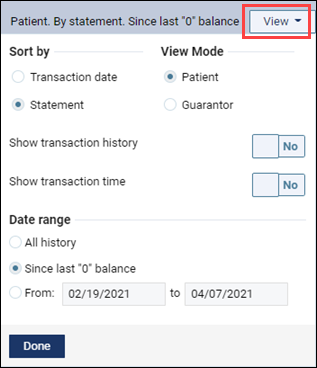The Ledger contains individual line items for every completed procedure, insurance claim, payment, and adjustment made on the account. It can quickly get confusing to look at, particularly when viewing the activity for all of a guarantor’s account members. Fortunately, your view of the Ledger can be modified to reflect your needs and your workflow. This post is about knowing your options.
How to:
- On a patient’s Ledger page, click View to open a menu. This is where Ledger customization happens.

- Select your sort by, view mode, and date range options, and click Done.
Sort by options
- By Transaction date – Lists transactions in chronological order. This allows you to sort by the Transaction Date column to put the oldest or the most recent transactions at the top of the list. With this view, however, you lose the insurance claim grouping, and you cannot select the Since last “0” balance date range option.

- By Statement – Groups transactions according to the Transaction Date (date of service). Procedures, claims, adjustments, and payments associated with a certain date of service appear together. A feature of this view is that a running balance appears.

View Mode options
- Patient view – Lists transactions only for the selected patient. The patient’s balance will not reflect the guarantor’s balance if the guarantor provides coverage for multiple patients. Note that when the patient is the guarantor, this view mode is not an available option—only the guarantor view can be used.
- Guarantor view – Lists transactions for the patient, all patients who have the same guarantor as the patient, and the guarantor (if not the patient). Transactions for a given patient with the same Transaction Date are grouped together.

Show transaction history
With this switcher toggled to Yes, expand and collapse arrows (►, ▼) appear next to revised transactions, so you can see the history of those revisions. A button that lets you Expand All or Collapse All also appears.

Show transaction time
With this switcher toggled to Yes, a timestamp appears for the transaction and history.

Date range options
- All history – Lists all transactions for the entire history of the patient.
- Since last “0” balance – Lists transactions starting from whichever date the account last had a zero (0.00) balance. Note that this option is available only when the Sort by option is Statement.
- From (Date Range) – Lists transactions only within a specified date range. This is handy when you need to limit the number of entries to look through.
Additional Information
- When viewing the ledger by Statement, payments with an asterisk (*) indicate that the amount is applied to multiple visits (or patients) or procedures.
- The Transaction date option gives you the opportunity, if you select the Shows applied and remaining amount columns checkbox, to include two additional columns, Applied and Remaining. For each procedure, the amount of any payments that have been applied to that procedure appears in the Applied column, and the difference between the amount charged and the applied amount appears in the Remaining column.

- If you’re wondering what view you’re looking at, a description based on your selections always appears next to the View button.

- A view is device-specific. The selected view will remain the same on a computer for all users until someone changes it. It will not follow your user login around to other computers.
